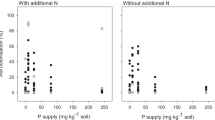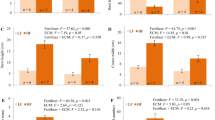Abstract
Commercial nursery practices usually fail to promote mycorrhization of interior Douglas-fir [Pseudotsuga menziesii (Mirb.) Franco var. glauca (Beissn.) Franco] seedlings in British Columbia, which may account for their poor performance following planting in the field. We tested the effects of four nursery cultivation factors (nitrogen fertilization, phosphorus fertilization, watering, and soil aeration) and field soil addition on mycorrhization, survival, growth, and biomass allocation of interior Douglas-fir seedlings in a series of greenhouse experiments. Where field soil was added to the growing medium, mycorrhization and root/shoot ratios were maximized at lower levels of mineral nutrient application and aeration. Where field soil was not added, mycorrhization was negligible across all fertilization and aeration treatments, but root/shoot ratio was maximized at lower levels of mineral nutrients and the highest level of aeration. Regardless of whether field soil was added, intermediate levels of soil water resulted in the best mycorrhizal colonization and root/shoot ratios. However, field soil addition reduced seedling mortality at the two lowest water levels. A cluster analysis placed ectomycorrhizal morphotypes into three groups (Mycelium radicis-atrovirens Melin, Wilcoxina, and mixed) based on their treatment response, with all but two morphotypes in the mixed group whose abundance was maximized under conditions common to advanced seedling establishment. For maximal mycorrhization and root development of interior Douglas-fir seedlings, nurseries should minimize addition of nitrogen and phosphorus nutrients, maximize aeration, provide water at moderate rates, and, where possible, add small amounts of field soil to the growing medium.





Similar content being viewed by others
References
Addy HD, Hambleton S, Currah RS (2000) Distribution and molecular characterization of the root endophyte Phialocephala fortinii along an environmental gradient in the boreal forest of Alberta. Mycol Res 104:1213–1221
Agerer R (1987–1998) Color atlas of ectomycorrhizas. Einhorn-Verlag Eduard Dietenberger, Schwäbisch Gmünd
Berch SM, Xiao G, Bulmer C (1999) Commercial mycorrhizal inoculants: value added conifers for site rehabilitation or just another way to spend money? Proceedings of the 19th Annual Meeting of the Forest Nursery Association of British Columbia. Extension Services, Tree Improvement Branch, Surrey, Canada
Brouwer R (1983) Functional equilibrium: sense or nonsense? Netherlands J Agric Sci 31:335–348
Campbell DB, Jones MD, Kiiskila S, Bulmer C (2003) Two-year field performance of lodgepole pine seedlings: effects of container type, mycorrhizal fungal inoculants, and site preparation. BC J Ecosyst Manage 3:1–11
Cázares E, Trappe JM, Jumpponen A (2005) Mycorrhiza–plant colonization patterns on a subalpine glacier forefront as a model system of primary succession. Mycorrhiza 15:405–416
Chapin FS III, Matson PA, Mooney HA (2002) Principles of terrestrial ecosystem ecology. Springer, Berlin
Chapman WK (1991) Inoculation of ectomycorrhizal fungi in the IDFdk2 biogeoclimatic zone of British Columbia: new techniques, fungi and outplanting trials. PhD thesis, University of British Columbia, Vancouver, Canada
Conjeaud C, Scheromm P, Mousain D (2006) Effects of phosphorus and ectomycorrhiza on maritime pine seedlings (Pinus pinaster). New Phytol 133:345–351
Deacon JW, Fleming LV (1992) Interactions of ectomycorrhizal fungi. In: Allen MF (ed) Mycorrhizal Functioning: an integrative plant–fungal process. Chapman and Hall, London, pp 249–300
Dickie IA, Reich PB (2005) Ectomycorrhizal fungal communities at forest edges. J Ecol 93:244–255
Dickie IA, Koide RT, Steiner KC (2002) Influences of established trees on mycorrhizas, nutrition, and growth of Quercus rubra seedlings. Ecol Monogr 72:505–521
Dickie IA, Schnitzer SA, Reich PB, Hobbie SE (2005) Spatially disjunct effects of co-occurring competition and facilitation. Ecol Lett 8:1191–1200
Duñabeitia MK, Hormilla S, Garcia-Plazaola JI, Txarterina K, Arteche U, Becerril JM (2004) Differential responses of three fungal species to environmental factors and their role in the mycorrhization of Pinus radiata D Don. Mycorrhiza 14:11–18
Garbaye J (2000) The role of ectomycorrhizal symbiosis in the resistance of forests to water stress. Outlook Agric 29:63
Goodman DM, Durall DM, Trofymow JA, Berch SM (1996) Describing ectomycorrhizas: a manual of concise descriptions of North American ectomycorrhizas. Mycologue, Sydney
Greisbauer H (2008) Regional, ecological and temporal patterns in Douglas-fir climate–growth relationships in the British Columbia Interior. Master's thesis, University of Northern British Columbia, Prince George, Canada
Hartnett DC, Wilson GWT (2002) The role of mycorrhizas in plant community structure and dynamics: lessons from grasslands. Ecology 80:1187–1195
Heineman JL, Hope GD, Simard SW, Vyse A, Lloyd DL, Miege DJ (2003) The effects of site preparation and harvesting practices on planted seedling productivity and microenvironment in southern interior dry, grassy Interior Douglas-fir forests. British Columbia Ministry of Forests, Victoria, Canada. Tech. Rep. 009
Hobbie EA, Colpaert JV (2003) Nitrogen availability and colonization by mycorrhizal fungi correlate with nitrogen isotope patterns in plants. New Phytol 157:115–126
Hoeksema JD, Bruna EM (2000) Pursuing the big questions about interspecific mutualism: a review of theoretical approaches. Oecologia 125:321–330
Hoeksema JD, Kummel M (2003) Ecological persistence of the plant–mycorrhizal mutualism: a hypothesis from species coexistence theory. Am Nat 162:S40–S50
Hoeksema JD, Schwartz MW (2003) Expanding comparative-advantage biological market models: contingency of mutualism on partners' resource requirements and acquisition trade-offs. Proc R Soc Lond Series B 270:913–919
Horton TR, Cazaras E, Bruns TD (1998) Ectomycorrhizal, vesicular–arbuscular and dark septate fungal colonization of bishop pine (Pinus muricata) seedlings in the first 5 months of growth after wildfire. Mycorrhiza 7:11–18
Horton TR, Bruns TD, Parker VT (1999) Ectomycorrhizal fungi associated with Arctostaphylos contribute to Pseudotsuga menziesii establishment. Can J Bot 77:93–102
Hunt GA (1992) Effects of mycorrhizal fungi on quality of nursery stock and plantation performance in the southern interior of British Columbia. FRDA Report ISSN 0835-0752; 185
Ingleby K, Mason PA, Last FT, Fleming LV (1990) Identification of ectomycorrhizas. HMSO London. ITE research publication no. 5
Jany J-L, Martin F, Garbaye J (2003) Respiration activity of ectomycorrhizas from Cenococcum geophilum and Lactarius sp. in relation to soil water potential in five beech forests. Plant Soil 255:487–494
Johnson NC, Graham JH, Smith FA (1997) Functioning of mycorrhizal associations along the mutualism–parasitism continuum. New Phytol 135:575–586
Johnson NC, Rowland DL, Corkidi L, Egerton-Warburton L, Allen EB (2003) Nitrogen enrichment alters mycorrhizal allocation at five mesic to semiarid grasslands. Ecology 84:1895–1908
Johnson NC, Hoeksema JD, Bever JD, Chaudhary VB, Gehring C, Klironomos J, Koide R, Miller RM, Moore J, Moutoglis P, Schwartz M, Simard S, Swenson M, Umbanhowar J, Wilson G, Zabinski C (2006) From Lilliput to Brobdingnag: extending models of mycorrhizal function across scales. Bioscience 56:889–900
Jones MD, Smith SE (2004) Exploring functional definitions of mycorrhizas: are mycorrhizas always mutualisms? Can J Bot 82:1089–1109
Jones MD, Durall DM, Harniman SMK, Classen DC, Simard SW (1997) Ectomycorrhizal diversity of Betula papyrifera and Pseudotsuga menziesii seedlings grown in the greenhouse or in single-species and mixed plots in southern British Columbia. Can J Forest Res 27:1872–1889
Jones MD, Durall DM, Cairney JWG (2003) Ectomycorrhizal fungal communities in young forest stands regenerating after clearcut logging. New Phytol 157:399–422
Jumpponen A (2001) Dark septate endophytes—are they mycorrhizal? Mycorrhiza 11:207–211
Jurgensen MF, Harvey AE, Graham RT, Page-Dumroese DS, Tonn JR, Larsen MG, Jain TB (1997) Impacts of timber harvesting on soil organic matter, nitrogen, productivity and health of inland Northwest forests. For Sci 43:234–251
Klironomos JN (2003) Variation in plant response to native and exotic mycorrhizal fungi. Ecology 84:2292–2301
Koide RT (1991) Nutrient supply, nutrient demand and plant response to mycorrhizal infection. New Phytol 117:365–386
Kolotelo D, van Steenis E, Peterson M, Bennett R, Trotter D, Dennis J (2001) Seed handling guidebook. British Columbia Ministry of Forests, Tree Improvement Branch, Victoria, Canada
Levang-Brilz N, Biondini ME (2002) Growth rate, root development and nutrient uptake of 55 plant species from the Great Plains Grasslands, USA. Plant Ecol 165:117–144
Lloyd D, Angrove K, Hope G, Thompson C (1990) A Guide to Site Identification and interpretation for the Kamloops Forest Region. Victoria, B.C.: Research Branch, B.C. Ministry of Forests
Mandyam K, Jumpponen A (2005) Seeking the elusive function of the root-colonizing dark septate endophytic fungi. Stud Mycol 53:173–189
Mandyam K, Jumpponen A (2008) Seasonal and temporal dynamics of arbuscular mycorrhizal and dark septate endophytic fungi in a tallgrass prairie ecosystem are minimally affected by nitrogen enrichment. Mycorrhiza 18:145–155
Marx DH, Hatch AB, Mendicino JF (1977) High soil fertility decreases sucrose content and susceptibility of loblolly pine to ectomycorrhizal infection by Pisolithis tinctorius. Can J Bot 55:1569–1574
Mason PA, Wilson J, Last FT (1983) The concept of succession in relation to the spread of sheathing mycorrhizal fungi on inoculated tree seedlings growing in unsterile soils. Plant Soil 71:247–256
McCune B, Grace JB (2002) Analysis of ecological communities. MjM Software Design, Gleneden Beach
Nara K (2006) Ectomycorrhizal networks and seedling establishment during early primary succession. New Phytol 169:169–178
Newsome TA, Sutherland DC, Vyse A (1991) Establishing Douglas-fir plantations in the dry belt of interior British Columbia. In: Baumgartner DM, Lotan JE (eds) Interior Douglas-fir: the species and its management. Washington State University, Cooperative Extension Service, Seattle, pp 227–233
Newton AC (1992) Towards a functional classification of ectomycorrhizal fungi. Mycorrhiza 2:75–79
Parke JL, Linderman R, Black C (1983) The role of ectomycorrhizas in drought tolerance of Douglas-fir seedlings. New Phytol 95:83–95
Perry DA, Amaranthus MP (1997) Disturbance, recovery and stability. In: Kohm KA, Franklin JF (eds) Creating a forestry for the 21st century: the science of ecosystem management. Island Press, Washington, pp 31–56
Perry DA, Amaranthus MP, Borchers JG, Borchers SL, Brainerd RE (1989) Bootstrapping in ecosystems. Bioscience 39:230–237
Reid CPP, Kidd FA, Ekwebelam SA (1983) Nitrogen nutrition, photosynthesis and carbon allocation in ectomycorrhizal pine. Plant Soil 71:415–432
Rillig MC (2004) Arbuscular mycorrhizas and terrestrial ecosystem processes. Ecol Lett 7:740–754
Rincón A, Parladé J, Pera J (2005) Effects of ectomycorrhizal inoculation and the type of substrate on mycorrhization, growth and nutrition of containerized Pinus pinea L. seedlings produced in a commercial nursery. Ann For Sci 62:817–822
Runion B, Mitchell RJ, Rogers HH, Prior SA, Counts TK (1994) Effects of nitrogen and water limitation and elevated atmospheric CO2 on ectomycorrhiza of longleaf pine. New Phytol 137:681–689
Schwartz MW, Hoeksema JD (1998) Specialization and resource trade: biological markers as a model of mutualisms. Ecology 79:1029–1038
Simard SW, Jones MD, Durall DM, Hope GD, Stathers RJ, Sorensen NS, Zimonick BJ (2003) Chemical and mechanical site preparation: effects on Pinus contorta growth, physiology and microsite quality on grassy, steep forest sites in British Columbia. Can J For Res 33:1495–1515
Simard SW, Hagerman SM, Sachs DL, Heineman JL, Mather WJ (2005) Conifer growth, Armillaria ostoyae root disease and plant diversity responses to broadleaf competition reduction in temperate mixed forests of southern interior British Columbia. Can J For Res 35:843–859
Stack RW, Sinclair WA (1975) Protection of Douglas-fir seedlings against Fusarium root rot by a mycorrhizal fungus in the absence of mycorrhiza formation. Phytopathology 65:468–472
Swaty RL, Deckert RJ, Whitham TG, Gehring CA (2004) Ectomycorrhizal abundance and community composition shifts with drought: predictions from tree rings. Ecology 85:1072–1084
Teste FP, Simard SW (2008) Mycorrhizal networks and distance from mature trees alter patterns of competition and facilitation in dry Douglas-fir forests. Oecologia 158:193–203
Teste FP, Schmidt MG, Berch SM, Bulmer C, Egger KN (2004) Effects of ectomycorrhizal inoculants on survival and growth of interior Douglas-fir seedlings on reforestation sites and partially rehabilitated landings. Can J For Res 34:2074–2088
Teste FP, Simard SW, Durall DM (2009) Role of mycorrhizal networks and tree proximity in ectomycorrhizal colonization of planted seedlings. Fungal Ecol 2:21–30
Treseder KK, Allen MF (2002) Direct nitrogen and phosphorus limitation of arbuscular mycorrhizal fungi: a model and field test. New Phytol 155:507–515
Twieg BD, Durall DM, Simard SW (2007) Ectomycorrhizal fungal succession in mixed temperate forests. New Phytol 176:437–447
Twieg BD, Durall DM, Simard SW, Jones MD (2009) Influence of soil nutrients on ectomycorrhizal communities in a chronosequence of mixed temperate forests. Mycorrhiza 19(5):305–316
Yang CS, Korf RP (1985) A monograph of the genus Tricharina and of a new, segregate genus, Wilcoxina (Pezizales). Mycotaxon 24:467–531
Author information
Authors and Affiliations
Corresponding author
Rights and permissions
About this article
Cite this article
Kazantseva, O., Bingham, M., Simard, S.W. et al. Effects of growth medium, nutrients, water, and aeration on mycorrhization and biomass allocation of greenhouse-grown interior Douglas-fir seedlings. Mycorrhiza 20, 51–66 (2009). https://doi.org/10.1007/s00572-009-0263-0
Received:
Accepted:
Published:
Issue Date:
DOI: https://doi.org/10.1007/s00572-009-0263-0




